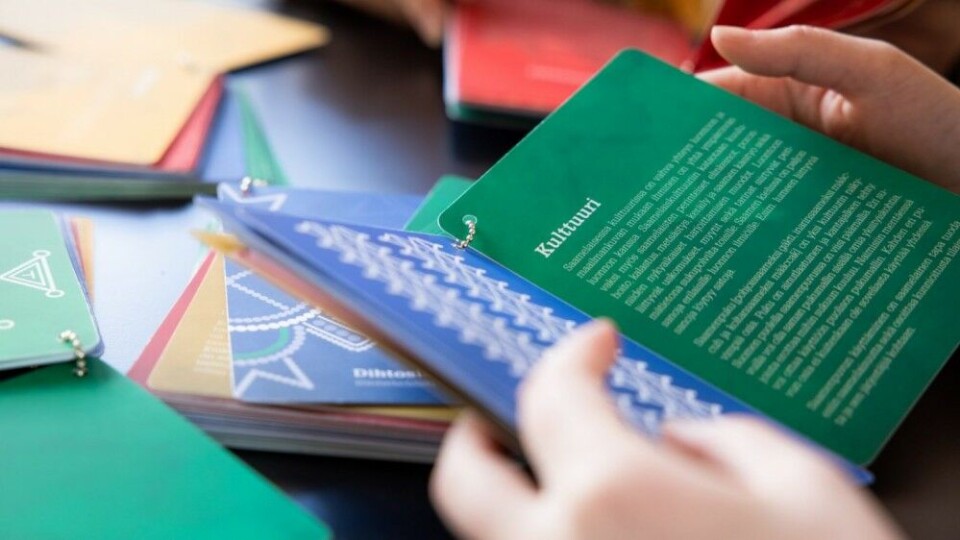![Members of the Sami Youth Council look at educational materials. “The most important thing about [the Dihtosis project] is that the wish for this project came from Sami youth themselves,” says Anni-Sofia Niittyvuopio, chair of the Youth Council of the Sami Parliament in Finland. Photo: Ville-Riiko Fofonoff/Youth Council of Sami Parliament in Finland](https://image.thebarentsobserver.com/131567.webp?imageId=131567&width=960&height=542&format=jpg)
Project to educate Finnish students about Sami needs to be permanent: Youth Council
Funding for a program to educate students about Sami culture in Finland ended on June 30, and project leaders say due to the success of the project, they will now work to make the curriculum permanent.
“We see the effects and the feedback is always amazing,” Anni-Sofia Niittyvuopio, chair of the Youth Council of the Sami Parliament in Finland, said in a phone interview. “It really surprised us this year. We did two times more [school] visits than usual and many more schools are ordering our videos.”
The Dihtosis project was started by the Youth Council in 2018.
The goal was to better educate Finnish students between the ages of 6 and 18 about Sami people and culture, in an effort to reduce prejudice and ignorance.
“We had a huge need for this project because our curriculums don’t involve knowledge about Sami enough, if they even have it at all, and that puts Sami youth at risk of racism, bullying, discrimination and hate speech,” Niittyvuopio said.
By youth for youth
Teachers in Finland are required to teach about the Sami, an Indigenous people whose homeland covers the Arctic areas of Sweden, Norway, Finland and Russia’s northwesternmost region, but there are no rules about what, and how, to teach about them, and much depends on an individual teacher’s interest and experience.
The Dihtosis project was put in place to help change this, by sending Sami youth into schools to teach lessons about their history, culture and Indigenous rights firsthand. Teachers and schools are also able to order videos of the lessons to use in their classrooms.
The curriculum is adjusted to according to age.
The Dihtosis project, young children are taught basic facts about who the Sami are and where their traditional territory is. Middle school children are taught about things like ILO 169, the United Nations International Labour Organization Convention that concerns the rights of Indigenous peoples, while high school students are taught about things like United Nations Declaration on the Rights of Indigenous Peoples and about the Sami parliament and what it does.

A recent paper (Finnish only) published on the project, done out of Finland’s Tampere University, interviewed teachers who’d received visits from the program and educators said the experience was invaluable.
“Many teachers were unsure how to present the Sámi people and the relationship with the state in a respectful way and avoid misinformation,” the paper said, citing everything from general societal silence on Sami issues to lack of direction from the government.
“The Dihtosis project was seen as a great help in these areas, creating understanding and connection.”
“Most people don’t understand what Sami face”
Niittyvuopio said ignorance of Sami life and culture are still rampant in Finland, and that making connections between youth is key to breaking down barriers.
“Colonialism is not just [Sami] history, it’s the history of the main population and of Finland, and that’s what people need to understand,”Niittyvuopio said.
“Most people don’t understand what Sami face. There may be discussions of things like land rights, but most Finns don’t recognize someone calling us “dirty laps” on the internet as hate speech.
“That’s why, in my opinion, the most important thing about [the Dihtosis project] is that the wish for this project came from Sami youth themselves. Sami youth wanted it, Sami youth felt the need for it.”
The Tampere University paper said the project’s unique approach leads to increased understanding.
![“Colonialism is not just [Sami] history, it’s the history of the main population and of Finland, and that’s what people need to understand,” says Anni-Sofia Niittyvuopio, chair of the Youth Council of the Sami Parliament in Finland Photo: Ville-Riiko Fofonoff/Youth Council of Sami Parliament in Finland](https://image.thebarentsobserver.com/131766.webp?imageId=131766&width=960&height=540&format=jpg)
“For the students, the fact that the message comes from Sámi youth was perceived as much more effective and meaningful than traditional book-based teaching,” the paper said.
“Empathy, participation, connection building, human rights and the breaking down of one-dimensional stereotypes are central to the program’s work.”
The Dihtosis project has been supported by Finland’s Ministry of Education and Culture, but that funding ran out on June 30.
Niittyvuopio says meetings will be held with the ministry this fall with a view towards making the program a permanent part of the Finnish curriculum.
This story is posted on the Barents Observer as part of Eye on the Arctic, a collaborative partnership between public and private circumpolar media organizations.















